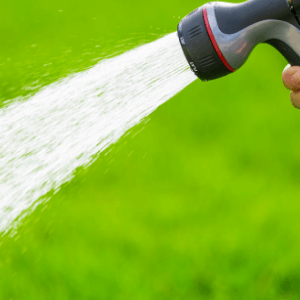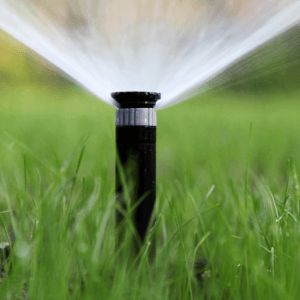Is it possible to have a lush lawn without the hefty water bill, or is getting lawn care services in St Catharines a better option? Before looking for lawn care experts, let's consider a few factors for having a healthy green lawn. Depending on the time of year and the climate you live in, the amount of water your lawn needs will vary.
In this article, we’ll discuss how you can maximise water use. We’ll also look at maintaining a watering schedule, which is one of the most important but often overlooked aspects.
Your grass needs around 1 inch of water every week from you, rainfall, or a combination of both to stay green and flourishing.
How to Determine How Long It Takes to Water Your Lawn
Set a series of containers with flat bottoms at 5-to 10-foot intervals from the sprinkler's base to the edge of its reach to determine how much water constitutes 1 inch. Time how long it takes for an inch of water to fall into each cup. Take this time as a starting point.
Lawn sprinklers with a series of cups spaced progressively further apart from the sprinkler head
Put a collection of cups downwind from your sprinkler to time how long it takes for 1 inch of water to accumulate in each one.
How to Maximise Water Use
Water thoroughly.
It's better to water your grass all at once rather than in small amounts throughout the day. Roots must first find a source of water to establish themselves. Roots can go deeper if you water them thoroughly. But if you just sprinkle the top of the soil without going any deeper, you'll have a very superficial root system.
For clay soil, once or twice weekly irrigation is sufficient. Because sandy soils can't retain even an inch of water, we'll need to apply the water in increments of two or three times per week.
In addition, if you notice water draining away from your grass, split treatments may be in order (for example, on a sloped landscape). Water should be absorbed rather than evaporated.
Water first thing in the morning.
The grasses will be awake and able to take in the necessary moisture levels. The grass blades will remain dry and disease-free thanks to the evaporation of any excess water. Watering your plants in the middle of the day is not a good idea because most of them will evaporate before your grass can use them.
It's not a good idea to water the lawn in the evening because the water will sit there all night, encouraging disease.
Hone your mowing skills.
This is crucial. Allow the grass to grow tall before cutting it. The taller the grass, the more time the roots have to grow down and establish themselves.
The soil will stay cooler and retain more moisture thanks to the shade provided by the long grass blades and the grass clippings. In your community, you’ll notice that lawns regularly mowed short and where clippings are gathered are usually the first to turn yellow.
Keep an eye on your self-setting timer.
While convenient, "set it and forget it" devices can waste water by watering the grass when it is adequately moist. When it's hot outside, don't water the yard. Don't water if it's raining or cloudy out.
The availability of rain and soil moisture sensors allows for the automatic shutoff of irrigation systems in the case of precipitation or excessive soil moisture.
Make your soil better.
Organic matter amendments can be helpful. Fill the holes left by the aerator with compost or peat moss the next time you aerate the lawn.
This organic material will aerate clay soils, allowing water to penetrate rather than pooling on the surface. It will also prevent water from quickly draining through sandy soils.
What is the proper watering schedule?
Here are some tips on creating a watering schedule that will keep your lawn looking its best all year.
Spring and Summer Watering Schedule
During the spring and summer months, your lawn will need about 1 to 1.5 inches of water per week. The best time to water your lawn is early in the morning before the sun gets too hot.
This gives the water a chance to soak into the ground before evaporation can occur. If you water in the evening, you risk fostering fungal growth on your lawn.
Autumn Watering Schedule
As temperatures start to cool down in autumn, you can reduce the amount of water your landscape receives to about 0.5 inches per week.
However, if you live in an area that experiences a long growing season, you may need to stick to the 1-inch-per-week schedule. Maintain this schedule until temperatures consistently stay below 60 degrees Fahrenheit at night.
Winter Watering Schedule
Once temperatures have dropped sufficiently, there is no need to keep watering the grass because it normally goes dormant in the winter. You might need to water your lawn once every several weeks during a moderate winter with little precipitation to keep it from turning brown.
Bottom Line
A well-watered lawn is a key to having a healthy landscape that looks its best all year long. By following these tips from your local lawn care services company in St Catharines, you can create a landscape watering schedule that will keep your grass green and vibrant all season long—regardless of where you live or what time of year it is.
Landscaping St Catharines—Who We Are
A beautiful, green lawn is every homeowner's dream. It's ideal for having a summer BBQ or doing activities with your kids. However, maintaining the aesthetic of your lawn takes time and effort, which most of us lack.
As a lawn care services company in St Catharines, we can offer you a monthly lawn care plan that will keep your lawn looking great all year with minimal effort. All you need to do is call and set up a free consultation. We are excited to show you what we can achieve for your home.
Please contact us as soon as possible to take advantage of our complimentary consultation!




